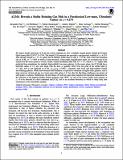Por favor, use este identificador para citar o enlazar a este item:
http://hdl.handle.net/10261/349378COMPARTIR / EXPORTAR:
 SHARE SHARE
 CORE
BASE CORE
BASE
|
|
| Visualizar otros formatos: MARC | Dublin Core | RDF | ORE | MODS | METS | DIDL | DATACITE | |

| Título: | ALMA reveals a stable rotating gas disk in a paradoxical low-mass, ultradusty galaxy at z = 4.274 |
Autor: | Pope, Alexandra; McKinney, Jed; Kamieneski, Patrick; Battisti, Andrew; Aretxaga, Itziar; Brammer, Gabriel; Diego, José María CSIC ORCID ; Hughes, David H.; Keller, Erica; Marchesini, Danilo; Mizener, Andrew; Montaña, Alfredo; Murphy, Eric J.; Whitaker, Katherine E.; Wilson, Grant; Yun, Min S. | Fecha de publicación: | 2023 | Editor: | IOP Publishing | Citación: | Astrophysical Journal Letters 951(2): L46 (2023) | Resumen: | We report ALMA detections of [C ii] and a dust continuum in Az9, a multiply imaged galaxy behind the Frontier Field cluster MACS J0717.5+3745. The bright [C ii] emission line provides a spectroscopic redshift of z = 4.274. This strongly lensed (μ = 7 ± 1) galaxy has an intrinsic stellar mass of only 2 × 109M⊙ and a total star formation rate of 26 M⊙ yr−1 (∼80% of which is dust-obscured). Using public magnification maps, we reconstruct the [C ii] emission in the source plane to reveal a stable, rotation-dominated disk with V/σ = 5.3, which is >2× higher than predicted from simulations for similarly high-redshift, low-mass galaxies. In the source plane, the [C ii] disk has a half-light radius of 1.8 kpc and, along with the dust, is spatially offset from the peak of the stellar light by 1.4 kpc. Az9 is not deficient in [C ii]; L[C II]/LIR = 0.0027, consistent with local and high-redshift normal star-forming galaxies. While dust-obscured star formation is expected to dominate in higher-mass galaxies, such a large reservoir of dust and gas in a lower-mass disk galaxy 1.4 Gyr after the Big Bang challenges our picture of early galaxy evolution. Furthermore, the prevalence of such low-mass dusty galaxies has important implications for the selection of the highest-redshift dropout galaxies with JWST. As one of the lowest stellar mass galaxies at z > 4 to be detected in a dust continuum and [C ii], Az9 is an excellent laboratory in which to study early dust enrichment in the interstellar medium. | Versión del editor: | https://doi.org/10.3847/2041-8213/acdf5a | URI: | http://hdl.handle.net/10261/349378 | DOI: | 10.3847/2041-8213/acdf5a | E-ISSN: | 2041-8213 |
| Aparece en las colecciones: | (IFCA) Artículos |
Ficheros en este ítem:
| Fichero | Descripción | Tamaño | Formato | |
|---|---|---|---|---|
| alma4274.pdf | 951,61 kB | Adobe PDF |  Visualizar/Abrir |
CORE Recommender
SCOPUSTM
Citations
4
checked on 24-may-2024
Page view(s)
16
checked on 28-may-2024
Download(s)
2
checked on 28-may-2024
Google ScholarTM
Check
Altmetric
Altmetric
Este item está licenciado bajo una Licencia Creative Commons

